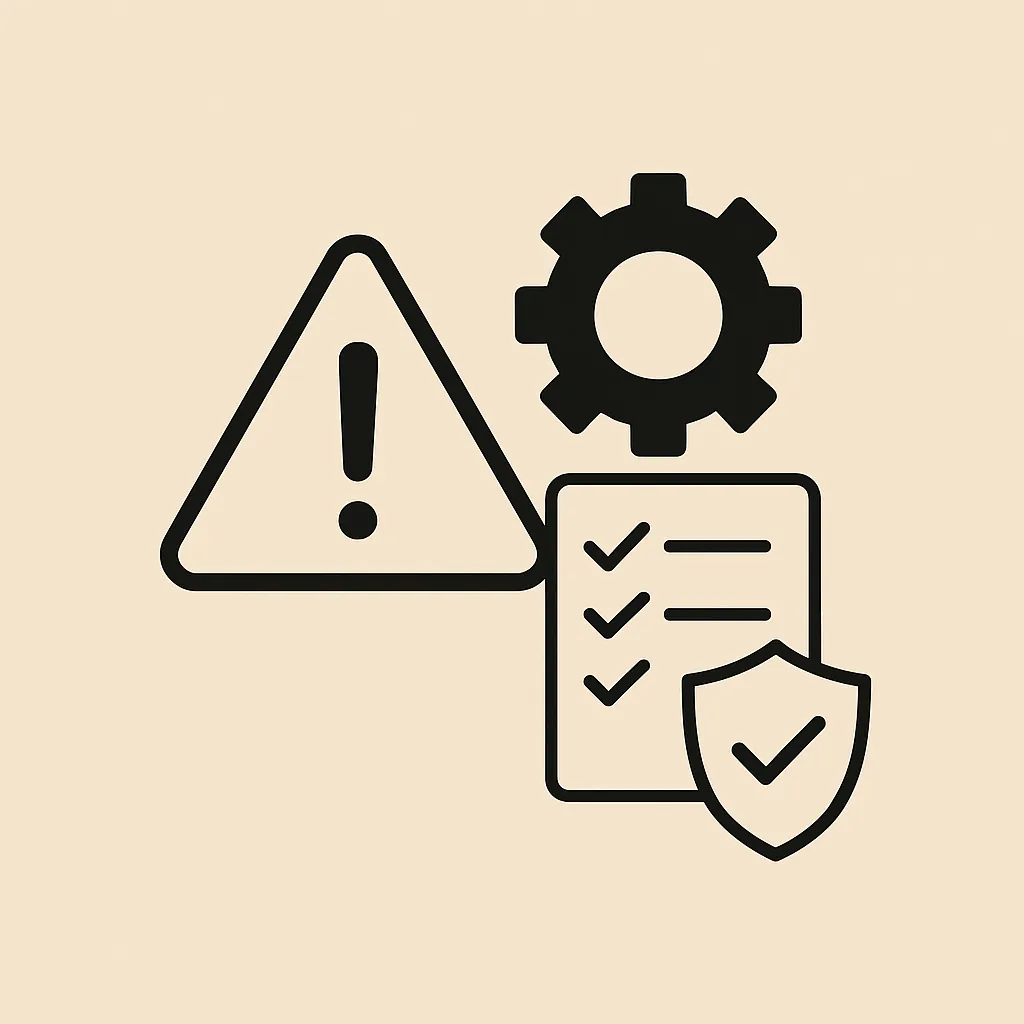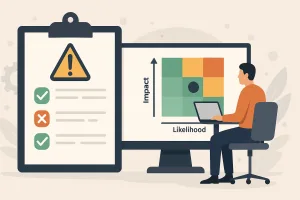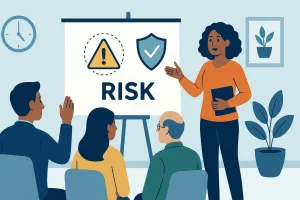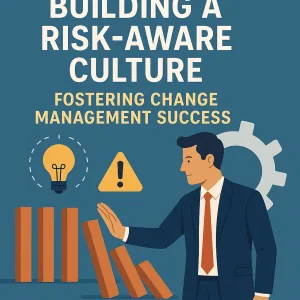Introduction to BIM and Risk Management
Particularly within the construction and architectural sectors, the integration of Building Information Modeling (BIM) has emerged as a transformative approach that significantly enhances risk management strategies. This section aims to define BIM, elucidate the concept of risk management, and underscore the critical importance of effective risk management in achieving successful project outcomes.
Defining Building Information Modeling (BIM)
Building Information Modeling (BIM) is a digital representation of the physical and functional characteristics of a facility. It serves as a shared knowledge resource for information about a facility, forming a reliable basis for decisions during its lifecycle, from inception onward. BIM encompasses a range of tools and processes that facilitate the creation and management of digital models, allowing project teams to visualize, simulate, and analyze various aspects of a project before actual construction begins. The significance of BIM in project management lies in its ability to improve collaboration among stakeholders, enhance communication, and streamline workflows, ultimately leading to more efficient project delivery.
Understanding Risk Management in Construction Projects
Risk management in the context of construction and architectural projects involves identifying, assessing, and prioritizing risks followed by coordinated efforts to minimize, monitor, and control the probability or impact of unfortunate events. This process is crucial as construction projects are inherently complex and fraught with uncertainties, including financial risks, safety hazards, and schedule delays. Effective risk management enables project leaders to anticipate potential issues, allocate resources wisely, and implement strategies that mitigate risks before they escalate into significant problems.
The Importance of Effective Risk Management
The importance of effective risk management cannot be overstated, as it directly impacts project outcomes. A well-structured risk management strategy helps ensure that projects are completed on time, within budget, and to the required quality standards. By proactively identifying and addressing risks, project teams can avoid costly delays and rework, enhance safety on job sites, and improve stakeholder satisfaction. Furthermore, effective risk management fosters a culture of accountability and continuous improvement, enabling organizations to learn from past experiences and refine their processes for future projects.
The integration of BIM into risk management strategies offers a powerful tool for project leaders and risk managers. By leveraging the capabilities of BIM, teams can enhance their ability to identify and mitigate risks, ultimately leading to more successful project outcomes. This discussion will further explore the specific ways in which BIM can be utilized to strengthen risk management practices in construction and architectural projects.
Understanding Risks in Construction Projects
Effective risk management is crucial for the successful delivery of projects. Building Information Modeling (BIM) has emerged as a transformative tool that enhances risk management strategies by providing a comprehensive framework for identifying, analyzing, and mitigating risks. This section will categorize the various types of risks faced in construction projects and discuss their potential impacts on timelines, budgets, and quality.
Categories of Risks
- Financial Risks
- Definition: These risks pertain to the financial aspects of a project, including cost overruns, funding shortages, and market fluctuations.
- Impact: Financial risks can lead to budget constraints, forcing project managers to make difficult decisions that may compromise project quality or scope.
- Operational Risks
- Definition: Operational risks arise from the day-to-day activities involved in project execution, such as scheduling delays, resource allocation issues, and workforce management.
- Impact: These risks can disrupt project timelines, leading to increased costs and potential penalties for late delivery.
- Legal Risks
- Definition: Legal risks involve compliance with regulations, contract disputes, and liability issues that may arise during the project lifecycle.
- Impact: Legal challenges can result in costly litigation, project delays, and damage to the reputation of the involved parties.
- Environmental Risks
- Definition: Environmental risks include factors such as adverse weather conditions, natural disasters, and environmental regulations that can affect project execution.
- Impact: These risks can lead to significant delays and additional costs, particularly if projects need to be redesigned to comply with environmental standards.
- Technical Risks
- Definition: Technical risks are associated with the technology and methodologies used in construction, including design flaws, equipment failures, and integration issues.
- Impact: Technical failures can compromise the integrity of the project, leading to safety hazards and increased costs for repairs or redesigns.
Impact of Risks on Project Outcomes
The various risks identified above can have profound effects on construction projects:
- Timelines: Delays caused by any of these risks can extend project schedules, leading to a domino effect on subsequent phases and potentially resulting in penalties for late completion.
- Budgets: Financial risks, in particular, can inflate project costs, necessitating budget revisions and potentially leading to funding shortfalls.
- Quality: Compromises made in response to risk management challenges can adversely affect the quality of the final deliverable, impacting client satisfaction and long-term viability.
How BIM Enhances Risk Identification
Building Information Modeling (BIM) has revolutionized the way project managers and risk managers approach risk identification and mitigation in construction projects. By leveraging advanced visual modeling and data analytics, BIM enhances the ability to foresee potential risks, allowing teams to address issues proactively rather than reactively. Here are some key points on how BIM contributes to effective risk management:
Role of Visual Modeling in Early Risk Identification
- Enhanced Visualization: BIM provides a three-dimensional representation of the project, allowing stakeholders to visualize the entire structure and its components. This visual clarity helps in identifying design flaws and construction risks at an early stage, which can significantly reduce costly changes later in the project lifecycle.
- Collaboration and Communication: The visual nature of BIM fosters better communication among project teams, including architects, engineers, and contractors. By having a shared visual model, teams can collaboratively identify potential risks related to design conflicts or construction methods, ensuring that all perspectives are considered before execution.
Data Analytics Features for Predicting Project Pitfalls
- Predictive Analytics: BIM systems often incorporate data analytics tools that analyze historical project data and current project parameters. This capability allows risk managers to identify patterns and trends that may indicate potential pitfalls, such as budget overruns or schedule delays.
- Scenario Analysis: BIM enables the simulation of various project scenarios, allowing teams to assess the impact of different variables on project outcomes. By running these simulations, project leaders can identify risks associated with specific design choices or construction schedules, leading to more informed decision-making.
Examples of BIM Tools for Risk Identification
- Clash Detection: One of the most significant advantages of BIM is its ability to perform clash detection. This tool identifies conflicts between different building systems (e.g., plumbing, electrical, and structural elements) before construction begins. By resolving these clashes in the design phase, teams can avoid costly rework and delays during construction.
- Simulation Tools: BIM software often includes simulation capabilities that allow project teams to model construction processes and workflows. For instance, tools like Navisworks and Revit can simulate construction sequences, helping to identify potential risks related to site logistics, resource allocation, and safety hazards.
- Integrated Risk Management Tools: Many BIM platforms now offer integrated risk management features that allow users to document, assess, and track risks throughout the project lifecycle. These tools enable project leaders to maintain a comprehensive risk register, ensuring that all identified risks are monitored and managed effectively.
BIM significantly enhances risk identification in project management by providing advanced visual modeling, predictive analytics, and specialized tools for clash detection and simulation. By adopting BIM, risk managers and project leaders can proactively address potential risks, leading to more successful project outcomes and reduced costs.
BIM for Risk Analysis and Assessment
Building Information Modeling (BIM) has revolutionized the way project managers approach risk management in construction and infrastructure projects. By leveraging BIM data and models, risk managers and project leaders can enhance their strategies for identifying, analyzing, and mitigating risks throughout the project lifecycle. Here’s how BIM facilitates a deeper understanding of risks through comprehensive analysis.
1. Risk Assessment Using BIM Data and Models
The process of risk assessment in BIM involves several key steps:
- Data Integration: BIM allows for the integration of various data sources, including design, construction, and operational data. This comprehensive dataset provides a holistic view of the project, enabling risk managers to identify potential risks early in the project lifecycle.
- Visualization: With 3D models, stakeholders can visualize the project in a way that traditional 2D drawings cannot. This visualization helps in identifying design flaws, construction conflicts, and other potential risks that may not be apparent in conventional documentation.
- Quantitative Analysis: BIM models can be used to perform quantitative risk assessments. By analyzing the data embedded in the models, project teams can calculate the likelihood and impact of various risks, allowing for more informed decision-making.
2. Simulating Different Risk Scenarios (What-If Analysis)
BIM excels in enabling what-if analyses, which are crucial for effective risk management:
- Scenario Planning: BIM allows project teams to simulate various scenarios and their potential impacts on the project. For instance, teams can model the effects of delays, budget overruns, or design changes, helping them to understand how these factors could influence project outcomes.
- Dynamic Updates: As project conditions change, BIM models can be updated in real-time, allowing for continuous risk assessment. This dynamic capability ensures that risk managers are always working with the most current data, which is essential for effective risk mitigation.
- Impact Visualization: By visualizing the outcomes of different scenarios, project leaders can better communicate potential risks to stakeholders. This enhanced understanding fosters proactive risk management strategies and informed decision-making.
3. Importance of Collaboration and Communication
Effective risk management is inherently collaborative, and BIM enhances this aspect significantly:
- Stakeholder Engagement: BIM facilitates collaboration among various stakeholders, including architects, engineers, contractors, and clients. By providing a shared platform for communication, BIM ensures that all parties are aware of potential risks and can contribute to risk mitigation strategies.
- Interdisciplinary Coordination: The integration of different disciplines within a single BIM model allows for better coordination and identification of risks that may arise from conflicting interests or miscommunication among teams.
- Real-Time Feedback: BIM enables real-time feedback and updates, which are crucial for maintaining open lines of communication. This immediacy helps teams to address risks as they arise, rather than waiting for scheduled meetings or reports.
BIM significantly enhances risk management strategies by providing a robust framework for risk analysis and assessment. Through data integration, scenario simulation, and improved collaboration, BIM empowers risk managers and project leaders to identify and mitigate risks more effectively, ultimately leading to more successful project outcomes. By embracing BIM, organizations can transform their approach to risk management, ensuring that they are better prepared to navigate the complexities of modern construction projects.
Mitigating Risks with BIM Strategies
Building Information Modeling (BIM) has emerged as a transformative tool in project management, particularly in risk management. By leveraging BIM, project leaders and risk managers can enhance their strategies to identify, assess, and mitigate risks throughout the project lifecycle. Here are several key strategies for using BIM to effectively mitigate identified risks:
Streamlining Project Workflows to Reduce Operational Risks
- Enhanced Collaboration: BIM facilitates real-time collaboration among project stakeholders, including architects, engineers, and contractors. This collaborative environment helps to identify potential issues early in the design phase, reducing the likelihood of operational risks arising during construction. By ensuring that all parties have access to the same information, BIM minimizes misunderstandings and miscommunications that can lead to costly errors.
- Visualization and Simulation: The 3D visualization capabilities of BIM allow project teams to simulate various scenarios before actual construction begins. This proactive approach enables teams to foresee potential challenges and operational risks, such as clashes between different systems (e.g., electrical and plumbing), and address them before they escalate into significant problems.
Improving Resource Management and Scheduling to Avoid Delays
- Optimized Resource Allocation: BIM provides detailed insights into resource requirements, allowing project managers to allocate resources more effectively. By analyzing the data generated through BIM, teams can identify the optimal times to deploy labor and materials, thus avoiding bottlenecks and ensuring that resources are available when needed.
- Accurate Scheduling: With BIM, project leaders can create more accurate schedules that reflect the complexities of the project. The integration of scheduling tools within BIM platforms helps in tracking progress in real-time, allowing for timely adjustments to avoid delays. This capability is crucial in managing risks associated with time overruns, which can have significant financial implications.
BIM serves as a powerful tool for risk management in project management. By streamlining workflows, improving resource management, BIM enhances the ability of project leaders and risk managers to identify and mitigate risks effectively. Embracing BIM not only leads to more successful project outcomes but also fosters a culture of proactive risk management within organizations.
Challenges and Limitations of BIM in Risk Management
Building Information Modeling (BIM) has revolutionized the construction and project management landscape, particularly in enhancing risk management strategies. However, its integration into risk management is not without challenges. Here are some key limitations and concerns that project leaders and risk managers should consider:
- Data Integration Issues: One of the primary challenges of using BIM in risk management is the potential for data integration problems. BIM relies on various data sources, and inconsistencies or incompatibilities between these sources can lead to inaccurate risk assessments. For instance, if the data from different project stakeholders (architects, engineers, contractors) is not synchronized, it can create gaps in risk identification and mitigation strategies. This fragmentation can hinder the effectiveness of BIM in providing a comprehensive view of project risks.
- Learning Curve and Training Requirements: Effective utilization of BIM requires a significant investment in training and development. Many team members may not be familiar with BIM tools and processes, leading to a steep learning curve. This can slow down project timelines as teams adapt to new technologies. Additionally, ongoing training is necessary to keep up with updates and advancements in BIM software, which can be resource-intensive for organizations. Without adequate training, the potential benefits of BIM in risk management may not be fully realized.
- Technology Adoption and Resistance: Resistance to adopting new technologies is a common challenge in many organizations. Team members may be hesitant to embrace BIM due to a lack of understanding of its benefits or fear of change. This resistance can stem from concerns about job security, as some may perceive BIM as a threat to traditional roles. Overcoming this resistance requires strong leadership and a clear communication strategy that emphasizes the advantages of BIM in enhancing risk management and overall project outcomes.
- Cost Implications: Implementing BIM can involve significant upfront costs, including software purchases, training programs, and potential infrastructure upgrades. For some organizations, especially smaller firms, these costs can be a barrier to entry. While BIM can lead to long-term savings through improved efficiency and reduced risks, the initial investment may deter some project leaders from fully committing to its integration in risk management.
- Dependence on Technology: While BIM provides powerful tools for risk management, an over-reliance on technology can lead to complacency. Teams may become too dependent on BIM outputs without critically analyzing the data or considering external factors that could impact project risks. This can result in a false sense of security, where risks are underestimated or overlooked.
While BIM offers significant advantages for risk management in projects, it is essential to acknowledge and address these challenges. By understanding the limitations and proactively working to overcome them, project leaders and risk managers can better leverage BIM to enhance their risk management strategies and ultimately improve project outcomes.
Future Trends: The Evolving Role of BIM in Risk Management
Building Information Modeling (BIM) has revolutionized the construction and project management landscape, particularly in risk management. As we look to the future, several trends and emerging technologies are poised to further enhance BIM’s capabilities in identifying and mitigating project risks. Here are some key points to consider:
1. Emerging Technologies Enhancing BIM Capabilities
- Artificial Intelligence (AI) and Machine Learning: These technologies are increasingly being integrated into BIM processes. AI can analyze vast amounts of data to identify patterns and predict potential risks before they materialize. For instance, machine learning algorithms can assess historical project data to forecast delays or budget overruns, allowing project managers to take proactive measures [1].
- Internet of Things (IoT): The integration of IoT devices with BIM can provide real-time data on project conditions, such as environmental factors or equipment performance. This data can be crucial for risk assessment, enabling teams to respond swiftly to emerging issues [1].
- Augmented Reality (AR) and Virtual Reality (VR): These technologies can enhance visualization in BIM, allowing stakeholders to experience a project in a simulated environment. This immersive experience can help identify potential risks related to design and construction before they occur, facilitating better decision-making [1].
2. Integrated Risk Management Frameworks Utilizing BIM
- Holistic Risk Management Approaches: The future of risk management in projects will likely see a shift towards integrated frameworks that leverage BIM as a central component. By combining BIM with risk management tools, project teams can create a comprehensive view of potential risks across all project phases, from design to construction and operation [2].
- Collaboration and Communication: BIM fosters collaboration among various stakeholders, including architects, engineers, and contractors. This collaborative environment is essential for effective risk management, as it allows for the sharing of insights and concerns that may not be visible in traditional project management approaches [2].
- Data-Driven Decision Making: As BIM continues to evolve, the emphasis on data analytics will grow. Project leaders will increasingly rely on data-driven insights to inform their risk management strategies, ensuring that decisions are based on accurate and timely information [2].
3. Ongoing Education and Adaptation to New Tools and Methodologies
- Continuous Learning: As the construction industry embraces new technologies, risk managers and project leaders must commit to ongoing education. This includes staying updated on the latest BIM advancements and understanding how to effectively integrate these tools into their risk management practices [3].
- Adaptation to Change: The rapid pace of technological advancement means that project teams must be agile and willing to adapt to new methodologies. Embracing change will be crucial for organizations looking to maintain a competitive edge and effectively manage risks in their projects [3].
- Professional Development: Investing in training programs and workshops focused on BIM and risk management will empower teams to leverage these tools effectively. This investment in human capital is essential for fostering a culture of innovation and resilience in the face of project uncertainties [3].
The future of BIM in risk management is bright, with emerging technologies and integrated frameworks set to enhance the way project risks are identified and mitigated. By prioritizing ongoing education and adaptation, risk managers and project leaders can harness the full potential of BIM, ensuring successful project outcomes in an increasingly complex environment.
Conclusion
Particularly within the construction and engineering sectors, Building Information Modeling (BIM) has emerged as a transformative tool for enhancing risk management strategies. The integration of BIM into project workflows offers several significant benefits that can help risk managers and project leaders effectively identify and mitigate potential risks throughout the project lifecycle.
- Enhanced Visualization and Analysis: One of the primary advantages of BIM is its ability to provide detailed visualizations of project components. This capability allows teams to foresee potential issues before they arise, facilitating proactive risk identification. By simulating various scenarios, project leaders can analyze the impact of different variables on project outcomes, leading to more informed decision-making.
- Improved Collaboration and Communication: BIM fosters a collaborative environment where all stakeholders can access and share information in real-time. This transparency reduces misunderstandings and miscommunications, which are often sources of risk. By ensuring that everyone is on the same page, teams can work together to address potential challenges more effectively.
- Data-Driven Insights: The data generated through BIM processes can be invaluable for risk management. By leveraging analytics, project teams can identify patterns and trends that may indicate emerging risks. This data-driven approach enables more accurate forecasting and enhances the ability to implement timely interventions.
- Streamlined Change Management: Changes in project scope or design can introduce significant risks. BIM allows for better management of these changes by providing a clear framework for assessing their implications. This capability helps teams to adapt quickly and minimize disruptions, thereby safeguarding project timelines and budgets.
Given these benefits, it is crucial for risk managers and project leaders to adopt BIM strategies in their projects. Embracing BIM not only enhances risk management but also contributes to overall project success by improving efficiency, reducing costs, and increasing stakeholder satisfaction.
Find out more about Shaun Stoltz https://www.shaunstoltz.com/about/.
This post was written by an AI and reviewed/edited by a human.



